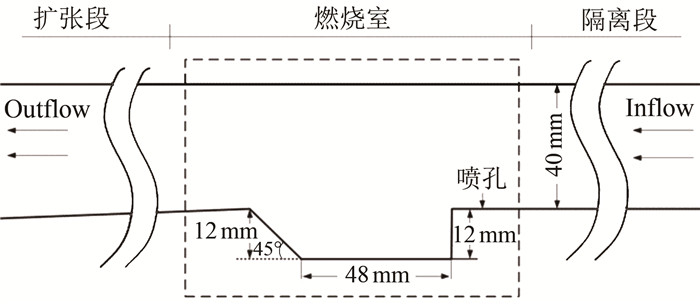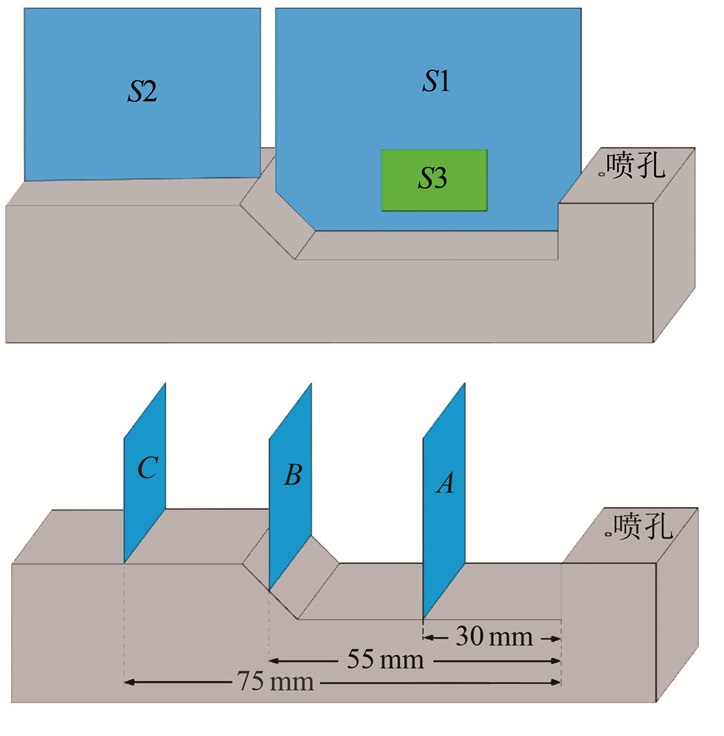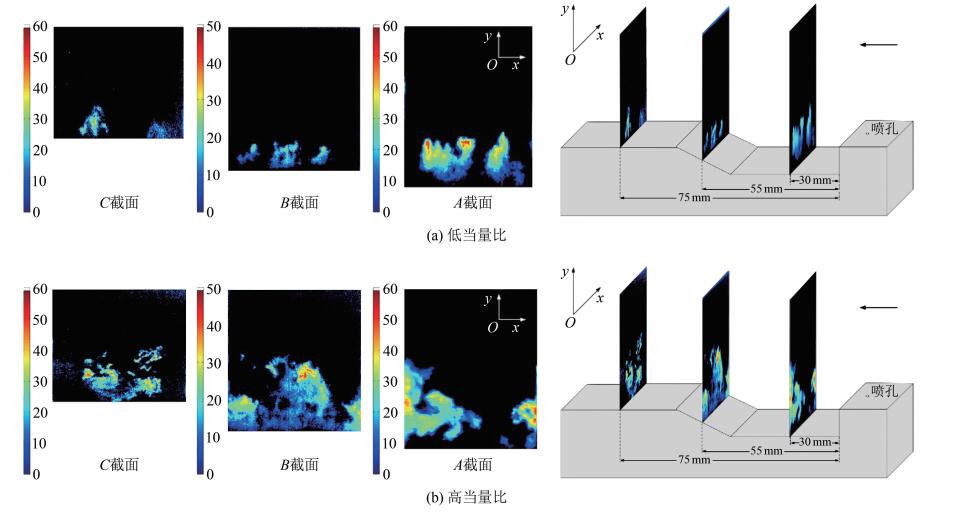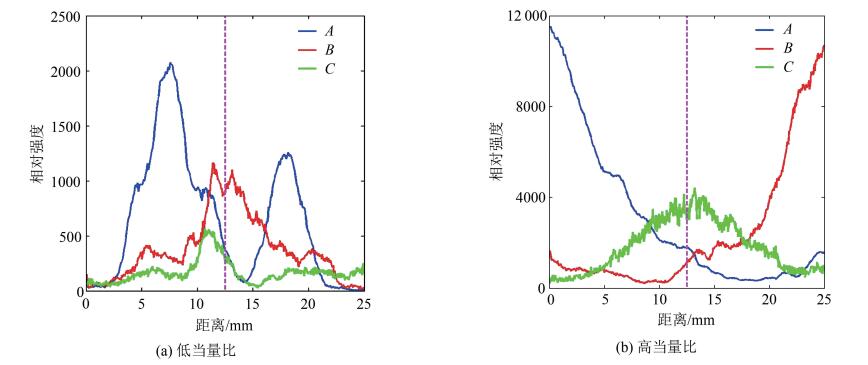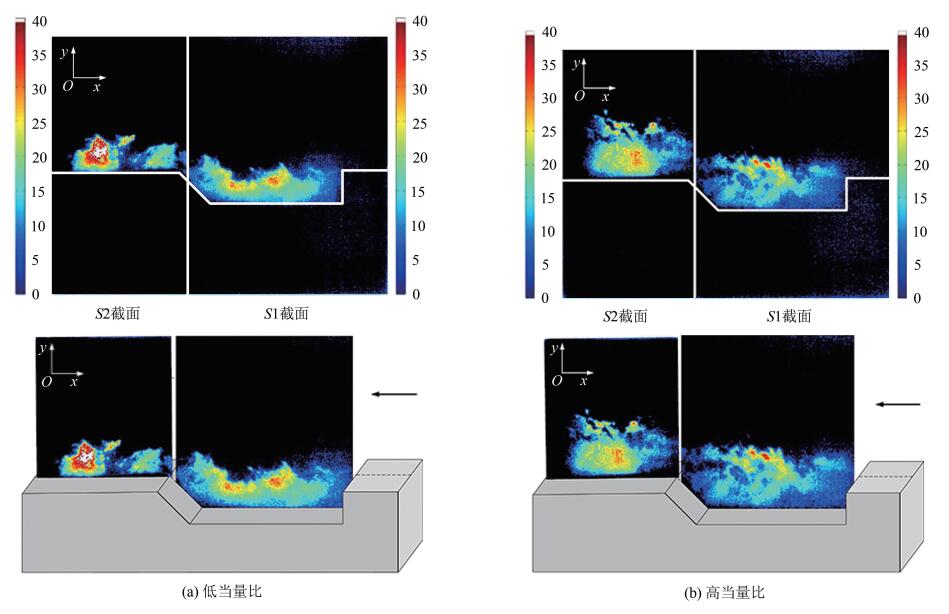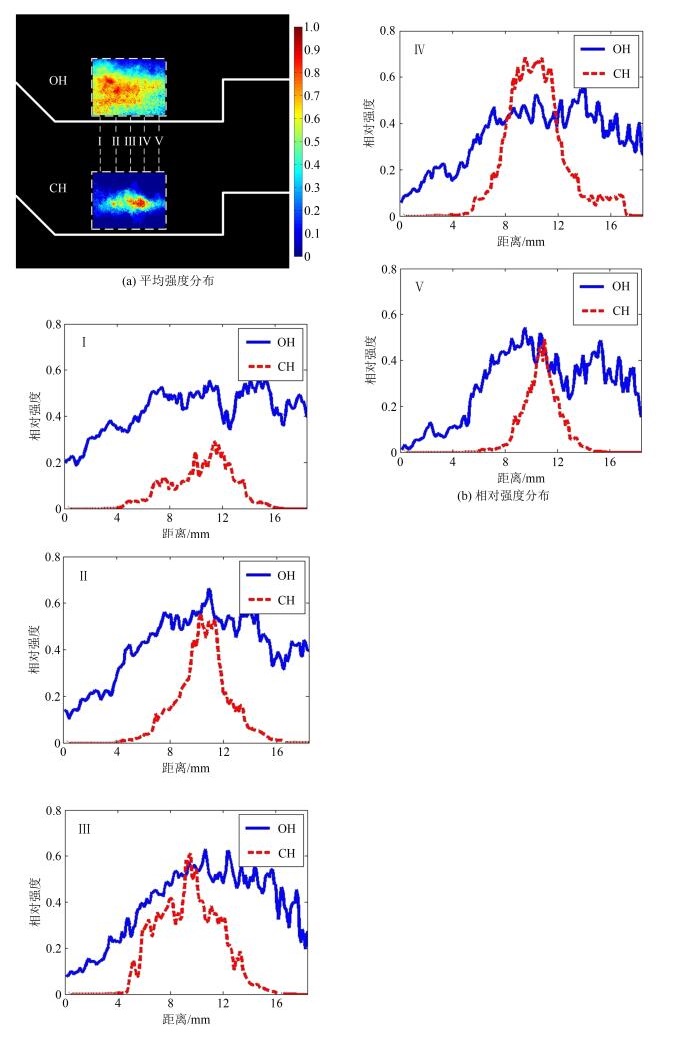Visualization of flame structure in supersonic combustion by Planar Laser Induced Fluorescence technique
-
摘要: 平面激光诱导荧光(PLIF)技术能够高时空分辨成像火焰结构并用于研究超声速燃烧机理。利用OH-PLIF与CH-PLIF技术研究了超声速燃烧的火焰结构。其中,利用OH-PLIF技术对燃烧室中3个展向截面与2个流向截面的凹腔稳定火焰反应区结构进行成像,利用CH-PLIF技术观测凹腔火焰放热区结构。实验结果表明:全局当量比较低时燃烧主要发生在凹腔中,OH沿中轴线对称分布;高当量比时火焰位置更高,OH主要沿燃烧室两侧壁面分布;CH所存在的超声速燃烧放热区呈现高度褶皱和破碎结构,放热区分布在比反应区更窄的区域。Abstract: Planar Laser Induced Fluorescence (PLIF) can be used to visualize the flame structure with high temporal and spatial resolution and investigate the mechanism of supersonic combustion. In this paper, OH-PLIF and CH-PLIF techniques were used to study the flame structure in supersonic combustion. The cavity-stabilized reaction zone structure of the three streamwise sections and two spanwise sections in a supersonic combustor was obtained by using the OH-PLIF technique. The experimental results show that the combustion occurs in the inner cavity and the OH radicals are distributed symmetrically along the central axis at a low global equivalence ratio. The OH radicals are primarily distributed at two-side-wall of the combustor and the location of the flame is higher than that of the cavity at a high equivalence ratio. The heat-release structure of the cavity-stabilized flame was observed by the CH-PLIF technique. It is found that the heat-release zone is highly wrinkled and distorted in the supersonic combustion and it is distributed in a narrower region than the reaction zone.
-
0 引 言
随着我国航空航天技术的进步,高超声速飞行器超燃冲压发动机燃烧流场诊断受到越来越多的关注,瞬态流场参数的准确测量可以为发动机燃烧模型验证、燃烧效率分析和推阻力计算提供重要的基础数据[1-3]。其中,流场温度和燃烧产物组分是发动机燃烧过程中的2个关键参数,前者表征了燃烧所释放的热能大小和效率高低,后者表征了燃料成分配比和燃烧是否完全。由于受到热传递、气流波动、燃料分布、边界层效应等因素的影响,发动机燃烧流场通常具有一定的非均匀属性[4],因此,开展针对发动机非均匀燃烧场二维分布测量的研究显得尤为重要[5]。
可调谐激光吸收光谱(Tunable Diode Laser Absorption Spectroscopy, TDLAS)技术具有选择性好、测量精度高、响应速度快、抗干扰能力强、结构简单等独特优势,已经成为发动机流场诊断中一项重要的非接触定量测量技术[6-7]。由于TDLAS是一种路径积分测量技术,单一光路上测量得到的流场参数其实是沿路径积分的平均值,不能直接反映非均匀流场的内部信息和空间分布特点[8-9]。国内外的研究学者提出将TDLAS技术与计算机层析算法(Computed Tomography, CT)结合,通过交叉布置多路激光测量数据,实现非均匀燃烧流场参数的二维分布重建[10-15]。
TDLAS燃烧场分布二维重建目前主要有线性层析和非线性层析2种方案,线性层析是双波长比值测温法的延伸,即首先独立获得2个吸收系数场分布,再进一步通过吸收系数比值重建每一像元网格内的温度、浓度分布场。例如,2011年,美国弗吉尼亚大学Busa等[10]利用采集的多角度多方位下的2条水汽直接吸收光谱信号对超声速燃烧风洞出口的温度二维分布进行了测量,采用经典的滤波反投影算法进行流场重建。2016年,浙江大学张立芳等[11]利用水汽的2条直接吸收谱线(波长约
1398 nm),结合改进型的代数迭代算法重建了平焰炉的温度场分布图像。线性层析方法虽然相对成熟,但是重建精度依赖于投影光路数目,尤其是复杂燃烧流场,需要布置大量多方位、多角度的测量光束,才能重建出较为精确的流场参数二维分布结果[12]。非线性层析算法是利用同时扫描到的多条吸收谱线,建立最优化目标函数,对温度和浓度直接进行全局寻优求解的一种方法[14],该方法通过波长换空间的策略,大大简化了投影光路布局,非常适用于发动机受限空间测量。如2013年,马林等[15]利用非线性层析方法,首次在美国通用电子J85航空发动机燃烧室出口测量得到了温度和水汽浓度二维分布数据,证明了非线性全局寻优算法的可行性。目前,国内学者针对非线性层析重建方法的研究还较为欠缺,基本上停留在模拟仿真和实验室测量验证阶段[16, 17],针对发动机台架真实燃烧环境下的二维场分布测量尚未见有关报道。本文选取5只DFB激光器采用分时复用和多波长合束的方式,实现了单光路下水汽5条吸收谱线的同时扫描,然后集成TDLAS测量系统,并对系统进行实验室测量标定。利用1$ \times $16路分束器,实现11$ \times $5路正交测量光路布局下的交叉激光测量。在发动机台架试验中,利用TDLAS系统对超燃冲压发动机燃烧室扩张段燃烧全过程进行吸收光谱采集记录,再基于改进型的非线性全局寻优算法[18]获得点火、燃烧、熄火等状态下的温度场和水汽分压场分布数据,同时分析了发动机各个状态下的燃烧火焰特点和结构,验证TDLAS多线吸收场分布测量方法应用于实际发动机流场诊断的可靠性和准确性。
1 基本原理与算法设计
1.1 TDLAS测量原理
当一束频率为$ v $(单位为cm−1)的准直激光穿过一段路径距离为$ L $(单位为cm)的气体介质后,由于气体对激光辐射的吸收,入射光强会发生衰减,透射光强与入射光强的关系遵循Beer–Lambert定律:
$$ {I_t}(v) = {I_0}(v)\exp \left\{ { - \int_0^L {p(l)X(l){S_{vi}}[T(l)]\varPhi (v){\text{d}}l} } \right\} $$ (1) 式中:$ {I_t}(v) $和$ {I_0}(v) $分别表示透射光强和入射光强,$ p(l) $、$ X(l) $和$ T(l) $分别代表气体在探测位置$ l $处的总压、摩尔分数和吸收组分在探测位置$ l $处的温度,$ \varPhi (v) $是归一化的线型函数。因此$ \displaystyle\int_{ - \infty }^{ + \infty } {\varPhi (v)} {\text{d}}v = 1 $,$ {S_{vi}} $为气体分子吸收线强,对于特定吸收谱线,仅与温度有关。式(1)经过变形可以得到式(2):
$$ {A_{vi}} = \int {\ln [{I_0}(v)/{I_t}(v)]{\text{d}}v = \int_0^L {p(l)X(l){S_{vi}}(T){\text{d}}l} } $$ (2) 式中:$ {A_{vi}} $为积分吸光度。当激光穿过一段温度、浓度和压强均匀的气体介质时,积分吸光度可以表示为:
$$ {A_{vi}} = pX{S_{vi}}(T)L $$ (3) 1.2 多线吸收场分布重建算法
对于非均匀燃烧流场,温度和组分浓度是位置的函数。为了获得燃烧场二维分布结果,首先将待测流场横断面划分为离散网格组成的二维区域。此时,积分吸光度可表示为:
$$ {A}_{{L}_{j} ,\; {\lambda }_{i}}={{\displaystyle {\sum }_{m \;=\; 1}^{M}{\displaystyle {\sum }_{n\;=\;1}^{N}[(PX{)}_{m,\;n}S({T}_{m,\;n})]_{\lambda_{i} }}}}{L}_{j,\;(m,\;n)} $$ (4) 式中:$ {L_j} $表示第$ j $条激光光路,$ {\lambda _i} $表示第$ i $个吸收波长,$(m,\;n)$表示网格的坐标索引,${L_{j,\;(m,\;n)}}$表示第$ j $条激光光路在网格$(m,\;n)$处的截距。对于不同的吸收线$ {\lambda }_{i} $和不同的投影方位$ {L}_{j} $,均有式(4)所表示的投影方程,其中$ A $为投影值。重建区域被划分为$ M\times N $的二维离散网格,利用同时扫描过的多条吸收谱线进行最优化迭代重建,重建过程考虑测量投影值和重建伪投影的误差,以及温度、组分浓度局域平滑准则,构造出最优化条件为式(5)的目标函数:
$$ \begin{split}&F[{T^{{\text{rec}}}},(p{X)^{{\text{rec}}}}] = D[{T^{{\text{rec}}}},(p{X)^{{\text{rec}}}}] +\\& {\gamma _T}{R_T}({T^{{\text{rec}}}}) + {\gamma _{pX}}{R_{pX}}[(p{X)^{{\text{rec}}}}] \end{split}$$ (5) 式中:$ D $为归一化的投影误差平方和;$ R $为像元与邻近像元均值之差的平方和,以表征局域均匀程度;$ \gamma $为相应的平滑因子;上标rec表示重建结果;${R_{pX}}$和$ {R_T} $的形式一致,$ D $和$ {R_T} $的计算方法如下:
$$ D[{T^{{\text{rec}}}},(p{X)^{{\text{rec}}}}] \;=\; \sum\limits_{j\;=\; 1}^J {\sum\limits_{i \;=\; 1}^I {\frac{{{{[{A_{\rm{m}}}({L_j},{\lambda _i}) - {A_{\rm{c}}}({L_j},{\lambda _i})]}^2}}}{{{A_{\rm{m}}}{{({L_j},{\lambda _i})}^2}}}} } $$ (6) $$ \begin{split}&{R_T}(T) \;=\; \sum\limits_{m \;=\; 1}^M {\sum\limits_{n \;=\; 1}^N [{T_{m,\;n}} - \frac{1}{8}({T_{m - 1,\;n - 1}} + {T_{m - 1,\;n}} +}\\&{ {T_{m - 1,\;n + 1}} + {T_{m,\;n - 1}} + {T_{m,\;n + 1}} + {T_{m + 1,\;n - 1}} + {T_{m + 1,\;n}} +}\\&{ {T_{m + 1,\;n + 1}})]^2}\\[-10pt]\end{split} $$ (7) 式中:$ {A_{\rm{m}}} $为实际测量投影值,$ {A_{\rm{c}}} $为模拟计算投影值,$ J $为投影光路总数,$ I $为吸收谱线总数。
多线吸收重建即寻找最优解使得目标函数$F[{T^{{\rm{rec}}}},(p{X)^{{\rm{rec}}}}]$值最小,此时$ T $和$pX$分布即认为是流场中温度场和分压场真实分布。与文献[15-16]相比,本文利用改进型模拟退火全局寻优算法求解目标函数的最小值,采用了全局和局部搜索结合、退火温度控制和回温设计等策略,大大缩短了算法计算时间,详见本研究团队前期发表的文章[18]。
2 TDLAS测量系统
针对超燃冲压发动机直连台燃烧室扩张段场分布测量需求,筛选5条近红外水汽吸收谱线,如表1所示,各条吸收谱线在高温环境下吸收较强,可以保证良好的信噪比。此外,谱线低态能级值均较高(
1045.06 ~3319.45 cm−1),可以实现高温流场的吸收光谱敏感响应;相邻谱线之间的低态能级值差距合理,有利于宽范围温度场的准确测量。为了实现流场温度和组分的精确测量,在实际发动机燃烧流场吸收光谱测量中,表1筛选的谱线吸收线强参数采用实验室测量标定的结果,其中$ \lambda $表示所选谱线对应的波长,$ {v}_{0} $表示所选谱线对应的中心频率,$ {E''} $表示所选谱线对应的低态能级值,${S}_{vi,\;{\rm{H}}}$表示所选谱线在296 K下数据库中的线强,${S}_{vi,\;{\rm{M}}}$ 表示所选谱线在296 K下实验室标定的线强。表 1 筛选的水汽吸收谱线光谱参数Table 1 Selected water vapor absorption spectral parameters$ \lambda $/
nm$ {v}_{0} $/
cm−1${E}{{'}{'} }$/
cm−1${S}_{vi,\;{\rm{H}}}$/
(cm−1atm−1)${S}_{vi,\;{\rm{M}}}$/
(cm−1atm−1)1339 7467.77 2551.48 1.27 × 10−5 1.093 × 10−5 1343 7444.36 1790.71 1.16 × 10−3 1.100 × 10−3 1392 7185.60 1045.06 1.97 × 10−2 1.905 × 10−2 1393 7179.75 1216.19 5.97 × 10−3 5.814 × 10−3 1469 6807.83 3319.45 6.17 × 10−7 6.032 × 10−7 在吸收谱线选择的基础上,集成了一套TDLAS多线吸收场分布测量样机,样机包含16对光耦收发探头、16条电子学信号放大电路、电子学测量主机、数据采集系统等。电子学测量主机主要包含5只DFB激光器的驱动控制电路、分时出光电路、1只线性电源、2只保偏合束器、1个波分复用器,以及一些光纤电缆等配套附件。
5只激光器采用分时复用的方式实现同时出光,系统测量频率4 kHz。采用波分复用器(WDM)与保偏合束器(PBS)联用方案,即对于相近波长(
1339 和1343 nm,1392 和1393 nm)用保偏合束器先进行合束复用到单根光纤传输,然后再和1469 nm整体合束,从而实现单光路下5个吸收波长的扫描获取。采用该定制复用器进行5个波长合束时,激光功率损耗小,满足台架试验多路分束测量需求。进行外场试验前,该TDLAS测量系统首先在实验室高温炉上开展了温度测量标定,利用高温炉营造的高温水汽标准温度环境,对设定的1000 ~1600 K恒温区内共7个温度台阶下的5条水汽吸收光谱进行测量,基于多线玻尔兹曼图测温法,获得了如图1所示的温度连续监测结果。与设定值相比,温度测量偏差在2.7%以内,验证了系统和方法的准确性。发动机台架燃烧室扩张段二维分布TDLAS测量示意图如图2所示,考虑到燃烧室扩张段光路布置的局限性,在垂直于高超声速气流方向布置二维测量激光正交光路共16条(水平方向5条,垂直方向11)条。本文先将激光信号调节至光斑打到通光窗片中心且亮度最高的最佳状态,然后拧紧加固每个探头的3个锁紧螺钉,相应的重建区域被划分为5 × 11的离散网格,场分布重建即是对这55个网格的温度和浓度共110个变量展开全局寻优迭代求解。
在进行发动机台架试验时,利用台架采集同步信号作为TDLAS测量主机的采集触发信号。当台架同步信号高电平到来时,使能主机本身的激光扫描同步触发信号,相应的数据采集系统开始多路数据同步时序采集,从而保证TDLAS系统测量数据和发动机燃烧工况在时序上的一致性。利用数据采集系统采集扩张段16条光路的激光吸收光谱信号。16路光谱信号由2个512 MB板载内存的8通道PCI
5105 采集卡同步采集完成,多组数据同步时序采集到板载内存中,然后一次性写入磁盘,16通道总采集时长约1.2 s,能够完整地记录发动机点火、燃烧到熄火的全过程试验测量数据。实际采集时,一个周期的采样点设置为7200 ,每个信号扫描周期包含5个激光器的直接吸收光谱,16个通道同时采集,共记录4620 个周期,板载内存占满时停止采集。3 数据处理与分析
TDLAS多线吸收燃烧场分布测量试验中,多路吸收光谱信号采用离线处理方式。首先对同步采集到的16路吸收光谱信号进行数据分割、读取、平均,然后进行无吸收基线拟合、激光波长时频转换、吸光度非线性拟合,最终获得积分吸光度、吸收中心频率、光谱展宽等拟合参数。其中,积分吸光度为多线吸收场分布重建算法中的投影数据,通过处理得到16条光路中所有5个吸收波长的积分吸光度数据,组成积分吸光度矩阵,即完成投影数据的计算;再将该投影数据代入到多线吸收场分布重建程序,即可计算出温度和水汽浓度的二维场分布图像。发动机燃烧场分布重建采用本文提出的模拟退火算法,计算机CPU主频2.8 GHz,单帧图像重建时间约484 s。总压$ p $和气体摩尔分数浓度$ X $作为整体进行重建,因此多线场分布重建算法计算出来的浓度二维分布其实是水汽的分压场分布。图3为发动机某烧油工况下经过平均的5个波长的直接吸收光谱信号和标准具干涉信号。
在进行发动机非均匀燃烧场二维分布测量之前,测量了单光路线平均温度,再基于单光路扫描获得的5条水汽吸收谱线,利用多吸收线玻尔兹曼图谱法,对16条测量光路下的流场参数线平均结果进行计算。图4为16条测量光路下测量得到的温度数据曲线图,时间分辨率为5 ms,记录了发动机从点火、燃烧到熄火整个工作过程的流场状态。从图中可以看出:发动机从450 ms左右开始点火燃烧,到680 ms左右达到燃烧温度最高值,经过一段时间的平稳燃烧,在
1250 ms左右发动机熄火,而后逐渐降温。为获得不同燃烧状态下发动机燃烧场二维分布图像,基于图4的线平均测量结果,选择了第680、
1000 和1400 ms时刻的16路激光吸收光谱数据进行场分布图像重建。图5和6为第680 ms时的发动机燃烧室扩张段温度场分布及对应的水汽分压场分布,此时的温度浓度值最高。图7和8分别为稳定燃烧时刻(第1000 ms)的温度场分布及对应的水汽分压场分布。图9和10分别为发动机熄火状态下(第1400 ms)重建的温度和水汽分压场分布。从燃烧流场二维场分布测量结果可以看出:发动机燃烧室扩张段温度和水汽分压场分布构型在不同时刻均具有良好的一致性;温度高的区域水汽浓度也相对较高,温度低的区域水汽浓度也相对较低;靠近上下边缘区域的温度和水汽浓度整体较高,符合燃烧室燃油从上、下喷嘴喷出燃烧的实际情况。具体来说,在发动机刚点火的第680 ms时,扩张段靠近上下壁面的区域温度较高,中心区域温度较低,水汽浓度分布也类似,并且温度浓度分布表现出大致的对称分布构型,此时处于燃油燃烧初始阶段,温度最高。在稳定燃烧段的
1000 ms时刻,温度已经有所降低,相对于刚点火的时刻,流场整体稍显均匀。最后在熄火的第1400 ms时刻,温度和水汽浓度下降到较低的稳定状态,分布也基本趋于均匀,直至发动机最终熄火。4 结 论
本文基于5只DFB激光器的时分复用系统,实现了单光路下5条水汽吸收谱线的同时扫描。集成了多线吸收场分布TDLAS测量系统,系统测量频率4 kHz,采用5$ \times $11离散网格共16条光路的正交激光光束布局,对超燃冲压发动机燃烧室扩张段温度和水汽分压二维场分布进行了台架试验测量,获得了所有16条光路下的5个吸收波长的高质量光谱数据,借助模拟退火全局优化算法实现了发动机烧油多状态下的燃烧温度场和水汽分压场分布的精确稳健重建,准确给出了不同状态下的场分布构型。本文的多吸收线场分布重建方法为非均匀复杂燃烧流场受限空间下的二维分布反演提供了重要的非接触测量手段,也为发动机燃烧模型验证和性能评估提供了定量分析工具。
-
表 1 PLIF实验系统配置
Table 1 The experimental system setup of PLIF
所测中间产物 OH CH 激发激光波长 ~283 nm ~387 nm 激光器系统 Nd:YAG泵浦的染料激光器(Sirah) 可调谐Alxanderite激光器 激光脉宽 ~10 ns ~100 ns 检测荧光波长 ~310 nm ~431 nm 能级跃迁 A-X B-X 相机 ICMOS PIMAX II ICCD 镜头 Nikon UV, f=105 mm, F/4.5 Nikon, f=50 mm, F/1.2 滤镜 UG11与WG305 431±10 nm带通 光学透镜组 凹柱面镜f=-40 mm, 凸柱面镜f=500 mm (流向)
凹柱面镜f=-40 mm, 凸柱面镜f=200 mm (展向)凹柱面镜f=-40 mm
凸柱面镜f=130 mm -
[1] 赵彪.高超声速飞行器技术发展研究[D].哈尔滨: 哈尔滨工业大学, 2010. http://cdmd.cnki.com.cn/Article/CDMD-10213-1011261474.htm ZHAO B. Research on the development of hypersonic vehicle technology[D]. Harbin: Harbin Institute of Technology, 2010. http://cdmd.cnki.com.cn/Article/CDMD-10213-1011261474.htm
[2] 金玲, 尚绍华.美国普惠公司吸气式高超声速推进技术发展综述[J].飞航导弹, 2007(1):55-58. http://d.old.wanfangdata.com.cn/Periodical/fhdd200701015 [3] 文科, 李旭昌, 马岑睿, 等.国外高超声速组合推进技术概述[J].航天制造技术, 2011(1):4-7, 20. http://d.old.wanfangdata.com.cn/Periodical/htgy201101002 WEN K, LI X C, MA C R, et al. Hypersonic combined-cycle propulsion technology based on scramjet[J]. Aerospace Manufacturing Technology, 2011(1):4-7, 20. http://d.old.wanfangdata.com.cn/Periodical/htgy201101002
[4] 王振国, 梁剑寒, 丁猛, 等.高超声速飞行器动力系统研究进展[J].力学进展, 2009, 39(6):716-739. http://d.old.wanfangdata.com.cn/Periodical/jmsj201802253 WANG Z G, LIANG J H, DING M, et al. A review on hypersonic airbreathing propulsion system[J]. Advances in Mechanics, 2009, 39(6):716-739. http://d.old.wanfangdata.com.cn/Periodical/jmsj201802253
[5] ECKBRETH A C. Laser diagnostics for combustion temperature species[M]. London:Gordon & Breach Publishers Ltd, 1988.
[6] 胡志云, 刘晶儒, 关小伟, 等.燃烧场参数的激光诊断技术研究[J].强激光与粒子束, 2002, 14(5):702-706. http://d.old.wanfangdata.com.cn/Periodical/qjgylzs200205015 HU Z Y, LIU J R, GUAN X W, et al. Study on laser diagnostics applied to combustion and flame[J]. High Power Laser and Particle Beams, 2002, 14(5):702-706. http://d.old.wanfangdata.com.cn/Periodical/qjgylzs200205015
[7] 李麦亮, 周进, 耿辉, 等.测量火焰中氢氧基分布的激光诱导荧光技术[J].国防科技大学学报, 2003, 25(3):10-13, 23. http://d.old.wanfangdata.com.cn/Periodical/gfkjdxxb200303003 LI M L, ZHOU J, GENG H, et al. Laser induced fluorescence technology for measurements of OH distribution in flames[J]. Journal of National University of Defense Technology, 2003, 25(3):10-13, 23. http://d.old.wanfangdata.com.cn/Periodical/gfkjdxxb200303003
[8] 朱家健, 赵国焱, 龙铁汉, 等. OH和CH2O平面激光诱导荧光同时成像火焰结构[J].实验流体力学, 2016, 30(5):55-60, 87. http://www.syltlx.com/CN/abstract/abstract10968.shtml ZHU J J, ZHAO G Y, LONG T H, et al. Simultaneous OH and CH2 O PLIF imaging of flame structures[J]. Journal of Experiments in Fluid Mechanics, 2016, 30(5):55-60, 87. http://www.syltlx.com/CN/abstract/abstract10968.shtml
[9] ZHOU B, BRACKMANN C, LI Z S, et al. Simultaneous multi-species and temperature visualization of premixed flames in the distributed reaction zone regime[J]. Proceedings of the Combustion Institute, 2015, 35(2):1409-1416. https://www.sciencedirect.com/science/article/pii/S154074891400265X
[10] ZHOU B. Advanced laser-based multi-scalar imaging for flame structure visualization towards a deepened understand-ing of premixed turbulent combustion[D]. Lund: Lund University, 2015. http://www.dissertation.com/abstracts/1371337
[11] CARTER C D, HAMMACK S, LEE T. High-speed flame front imaging in premixed turbulent flames using planar laser-induced fluorescence of the CH C-X band[J]. Combustion and Flame, 2016, 168:66-74. https://www.sciencedirect.com/science/article/abs/pii/S0010218016300414
[12] 耿辉, 翟振辰, 桑艳, 等.利用OH-PLIF技术显示超声速燃烧的火焰结构[J].国防科技大学学报, 2006, 28(2):1-6. http://d.old.wanfangdata.com.cn/Periodical/gfkjdxxb200602001 GENG H, ZHAI Z C, SANG Y, et al. Reveal the flame structure of supersonic combustion using OH-PLIF technology[J]. Journal of National University of Defense Technology, 2006, 28(2):1-6. http://d.old.wanfangdata.com.cn/Periodical/gfkjdxxb200602001
[13] 李麦亮, 周进, 耿辉, 等.平面激光诱导荧光技术在超声速燃烧中的应用[J].推进技术, 2004, 25(4):381-384. http://d.old.wanfangdata.com.cn/Periodical/tjjs200404022 LI M L, ZHOU J, GENG H, et al. Application of PLIF in research on supersonic combustion[J]. Journal of Propulsion Technology, 2004, 25(4):381-384. http://d.old.wanfangdata.com.cn/Periodical/tjjs200404022
[14] DONBAR J M, GRUBER M R, JACKSON T A, et al. OH planar laser-induced fluoroescence imaging in a hydrocarbon-fueled scramjet combustor[J]. Proceedings of the Combustion Institute, 2000, 28(1):679-687. DOI: 10.1016/S0082-0784(00)80269-6
[15] CANTU L M L, GALLO E C A, CUTLER A D, et al. OH PLIF visualization of a premixed ethylene-fueled dual-mode scramjet combustor[R]. AIAA-2016-1763, 2016.
[16] O'BYRNE S, STOTZ I, NEELY A, et al. OH PLIF imaging of supersonic combustion using cavity injection[R]. AIAA-2005-3357, 2005.
[17] MICKA D, DRISCOLL J. Reaction zone imaging in a dual-mode scramjet combustor using CH-PLIF[R]. AIAA-2008-5071, 2008.
[18] 梁剑寒, 李韵, 孙明波, 等.超声速燃烧火焰放热区结构CH-PLIF成像技术[J].国防科技大学学报, 2019, 41(1):27-33. http://d.old.wanfangdata.com.cn/Periodical/gfkjdxxb201901005 LIANG J H, LI Y, SUN M B, et al. CH-PLIF imaging of flame heat-release structures in supersonic combustion[J]. Journal of National University of Defense Technology, 2019, 41(1):27-33. http://d.old.wanfangdata.com.cn/Periodical/gfkjdxxb201901005






 下载:
下载:










